Posts Tagged: volunteer
All Systems Are 'Go'--and 'Green'--for UC Davis Biodiversity Museum Day
All systems are "go"--and "green"--for the 12th annual UC Davis Biodiversity Museum Day on Saturday, Feb. 18. This "Super Science Day"...
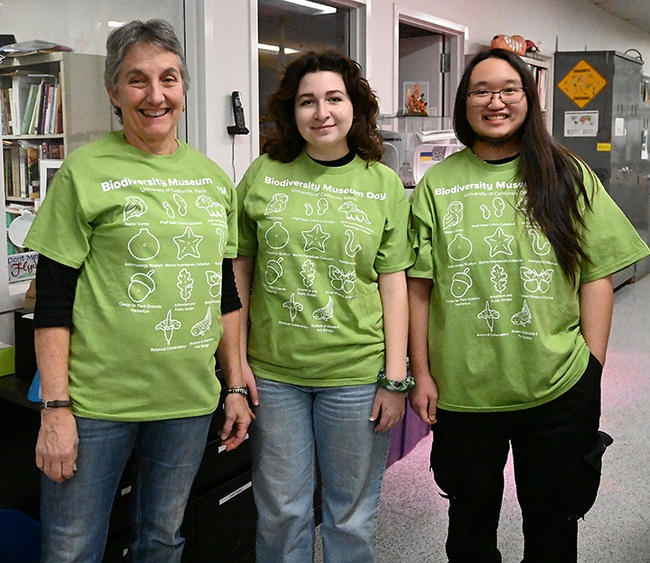
Wearing of the Green--Ready to greet the crowd at the Bohart Museum of Entomology on Feb. 18 are (from left) Lynn Kimsey, director of the Bohart Museum of Entomology and a UC Davis distinguished professor of entomology, and entomology students and Bohart associates, Sol Wantz, president of the Entomology Club, and Allen Chew. (Photo by Kathy Keatley Garvey)
Bohart Museum Associate Jeff Smith: A Monarch Kind of Day
Entomologist Jeff Smith, who curates the butterfly and moth collection at the Bohart Museum of Entomology, University of California, Davis, had a...
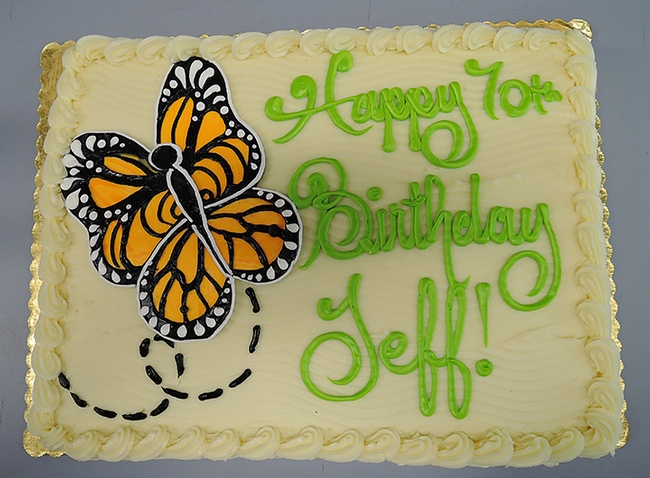
Entomologist Jeff Smith's 70th birthday cake featured a monarch butterfly motif. A 30-year volunteer at the Bohart Museum of Entomology, he curates the butterfly and moth collection. (Photo by Kathy Keatley Garvey)
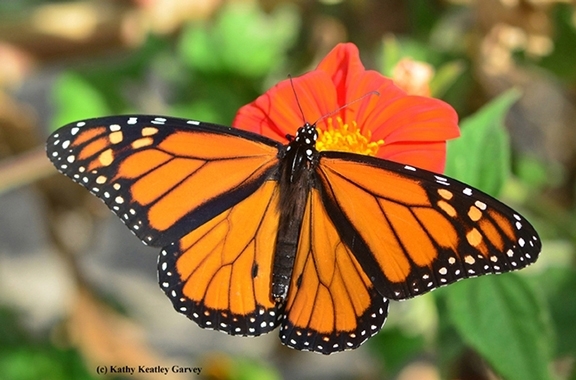
Smith's favorite butterflies so a monarch motif appeared on his surprise birthday cake. (Photo by Kathy Keatley Garvey)
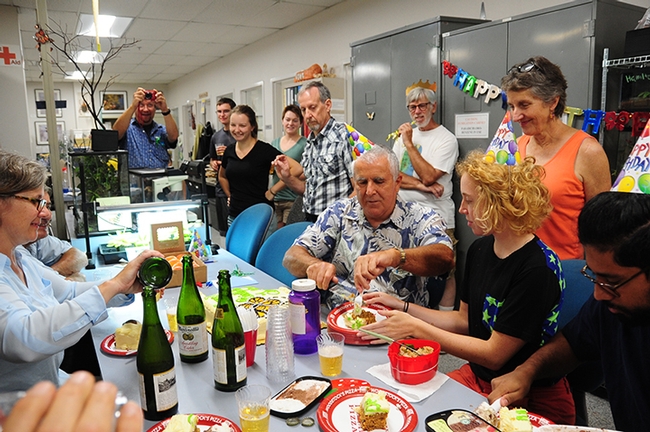
Entomologist Jeff Smith (center) is surrounded by friends and colleagues at his surprise birthday party. They enjoyed carrot cake, ice cream and sparkling apple juice. (Photo by Kathy Keatley Garvey)
Are You a Future Master Gardener?
A year ago I was sitting at home looking through the community calendar in the local monthly penny saver when I saw the application deadline for the Solano Master Gardener program. Curious about the program, I went to the website to read more about it which sounded interesting. Not considering myself to be a “real” gardener, since my experience was limited to annually growing a summer vegetable garden, it looked like a great opportunity to learn more about gardening. I never took a horticulture class, or even took the time to read any gardening books, but I decided it wouldn’t hurt to fill out the application for the program. I never imagined a year later I would be writing this blog post as a Master Gardener.
The initial knowledge, background, and experiences of individuals in each new class of Master Gardeners is different. We each journey through the program for different reasons. But upon graduation, we share a common knowledge, and a common goal of providing research based home horticulture information to the community.
Are you a potential future Master Gardener? Can you answer “yes” to any of these questions?
- Do you like gardening?
- Do you like helping others?
- Do you like learning new things?
- Do you like growing your own fruits and vegetables with little or no use of pesticides?
- Do you care about sustaining the land and the environment?
- Do you enjoy the company of like minded people?
- Are you interested in helping your community?
- Are you looking for a fun, meaningful volunteer opportunity?
If you answered yes to one or more of these questions, then consider applying for the 2014 Master Gardener class. There’s still time to apply before the October 31st deadline.
The benefits of being a Master Gardener are numerous. First, you’ll receive 16 weeks of horticultural education covering topics ranging from turf and landscape trees to weeds, water management, and entomology. The classes are taught by University of California and other local faculty, providing you with first class instruction. You’ll receive a copy of the 700 page California Master Gardener Handbook and a copy of the book Pests of Landscape Trees and Shrubs. On an ongoing basis you’ll receive information about upcoming horticulture related talks, workshops, webinars and other opportunities to expand your knowledge. And you’ll have access to UC research on horticultural topics of interest to home gardeners.
The Master Gardener program is a volunteer program so as a Master Gardener, you are required to provide a minimum number of approved volunteer hours in the community on an annual basis. But until I became a Master Gardener, I had no idea of the scope of the volunteer opportunities available. They are bountiful and the best part is you have the opportunity to choose only those that interest you. For example volunteer opportunities include providing gardening information to school children at special events, or working with children during library events presented by Master Gardeners, answering gardening questions at local farmers markets, providing training on composting, presenting a gardening talk at the library or other venue, helping maintain the Children’s Memorial garden, gardening with juvenile detainees at the New Foundations Juvenile Hall garden, or writing for the blog or newsletter. These are just some of the many community volunteer opportunities available to you as a Master Gardener.
If you’re interested in joining the camaraderie of over 100 Master Gardeners in Solano County, be sure to submit your application for the class of 2014 before the October 31st deadline. The application is accessible at http://cesolano.ucanr.edu.
If you have any questions about the application process or program, contact the Program Coordinator Jennifer Baumbach at (707) 784-1321 or jmbaumbach@ucanr.edu.

California Master Gardener Handbook and Pests of the Landscape Trees and Shrubs manuals. (photo by Kathy Low)
Super-star of My Side Yard
This past spring, while watering an Ash tree (Fraxinus) I planted in a small side yard several years back, I almost stepped on a Solanum lycopersicum. This tomato had sprouted next to an outdoor rocking chair that sat on a narrow gravel-covered strip of soil that was wedged between a small patch of concrete and the fence.
Over the weeks, as I watched the plant stretch upward and vine outward, this unexpected volunteer won my heart. I couldn’t bear to pull it up. So I did what bleeding heart gardeners do when stuck between rocks and hard places. I pounded in a stake to secure the tomato plant’s voluminous growth and draped its vines across the lap of the chair. When the concrete was no longer passable, I lifted the fruit-filled stems atop two plastic storage bins.
During my research into why this super star of my side yard is outperforming every tomato I ever planted in my entire life, I realize its success is mostly due to the soil, which was fallow for years, despite being gravel-covered clay. But I also learned that volunteer plants can increase nematode populations. Guess what? I can’t even reach the roots to inspect them for root knot nematodes (See UC ANR Publication 3470, Tomato nematodes).
Then I wondered if my volunteer is a disease resistant variety? I don’t know. All I know is what I see. Foliage over 6 feet tall and 6 feet wide and growing by the day. No evidence of chlorosis virus, spotted wilt or yellow leaf curl. No verticillium wilt or Mosaic virus — YET.
So . . . as I reap this year’s harvest, I envision next year’s volunteer — large, lush, lovely, drooping with pick-ready vine-ripe tomatoes. But I know super stars don’t last and reality gardening seldom measures up to the plot of dreams.

Volunteer tomato with chair. (photos by Launa Herrmann)

Volunteer tomato overgrowing chair.

Volunteer tomato harvest.
Become a Master Gardener
It's just about that time of year again. The Master Gardener Program will start recruiting new people to be a part of the 2013 Master Gardener Training class. In about a month, I will have the online applications ready for interested Solano County residents to apply.
The Master Gardener training class will begin in January, but there are a few steps before a person is seated as part of the training. First, the application will be completed and turned in by October 31, 2012. Once the applications are received, I will call and make interview appointments with the potential trainees. These interviews will happen from November 5-9. There will be a panel of 2-3 current Master Gardeners and myself who will do the interviewing. After the interviews are completed, the class will be picked. Space is limited, so we will take approximately 20-25 new trainees.
There will be an orientation in mid-December, and after that, the new trainees will show up for their first class in January 2013.
The class fee is $125.00, which includes receiving your CA Master Gardener Handbook, Pests of the Landscape Trees and Shrubs book, class materials/handouts, fingerprinting, and your official name badge, once you successfully complete the final exam.
The training class will meet every Friday from 9:00 a.m. until 1:00 p.m. They start early January and go through April. There is a final exam, which is open book-open note-open resource, at the end of the training class and then a graduation ceremony about a week later.
Each class is a stand-alone, so if you miss one class, you can be left behind very quickly. The instructors are packing into 4 hours of lecture, what a horticulture student might learn in a semesters worth of instruction for that particular topic.
Once a trainee has completed their final successfully, they are considered a certified Master Gardener and are then allowed to volunteer in the community-that is when the real fun begins!
If you have any questions, email me at jmbaumbach@ucdavis.edu.
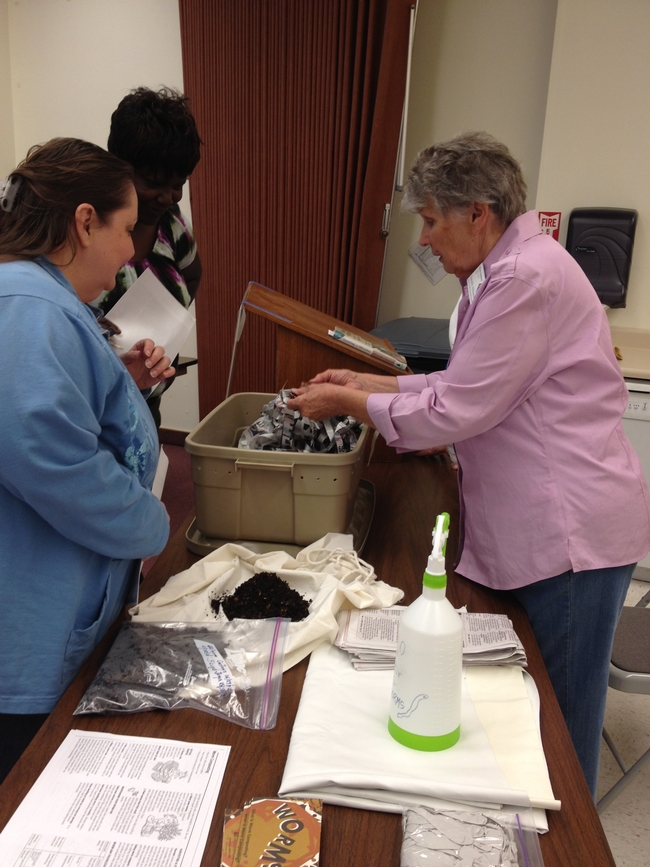
New Master Gardener Danielle talks with residents about worms and worm composting. (photos by Jennifer Baumbach)
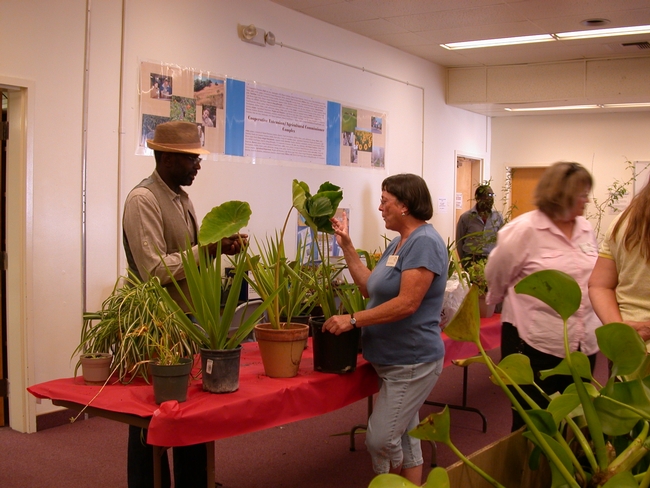
MGs Steve and Judy discuss a plant at our annual Public Plant Exchange.

MGs Kris and Mollie doing a spring cleanup at our Children's Garden in Fairfield.

